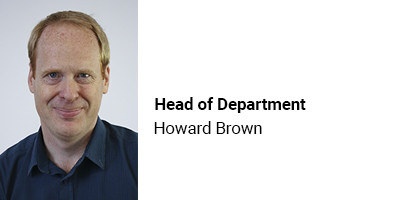History of Art A level
Qualification: GCE A level in History of Art
Exam Board & Specification Code: Pearson; 9HT0; Specification
Course Entry Requirements: 4 in English Language and 4 in English Literature. You may study History of Art and another History course if you wish.
Please make sure that you have understood the overall entry requirements to study at BHASVIC. These are available here and outline the GCSE grades you need to take up one of the Study Programmes at the college.
Length and size of qualification: 2 year single course
Timetable hours: 4.5 hours per week
Assessment method: 2 written exams
BHASVIC Department: Humanities

What will I study?
History of Art is a fascinating course that explores our global cultural heritage. It asks how the great masterpieces of art have been produced, what they mean and why they have such an impact on us. The course is built on three key elements: Visual Analysis; Themes and Periods. You begin with a course in visual literacy that equips you with the essential concepts, skills and vocabulary to understand fine art, sculpture and architecture. Themes are broad-based investigations into artistic developments and connections between movements and periods across time and space. You explore works in relation to two themes: Identities and Nature focusing on, for example gender, ethnicity and ecology. Finally, you focus on two artistic periods: the 17th century Baroque and Modernism in Europe at the start of the 20th century. Here you investigate the relationships between key artists such as Caravaggio and Picasso and the concepts and contexts that shaped their work such as the struggle between the Catholic and Protestant faiths and the devastating impact of the First World War. Throughout the course, you will learn how to analyse and make critical judgments about art while also building an understanding of the significance and contribution of key individual artists and the relationship between art, technology, society and politics across the entire world.
Is this course right for me?
History of Art is an excellent option for any student who is interested in visual culture and the world around them. It stands as a marvellous complement to practical visual arts subjects but would be of equal interest to English, History, Media, and Sociology or Politics students as it borrows approaches from all these disciplines. It is analytical in nature and is assessed by means of two written examination papers. Lessons are focused on images and always involve discussion of themes or key works. You will be encouraged to undertake individual research via reference works, films, television programmes or some of the huge range of podcasts and resources available via the internet. Moreover, we will have many opportunities for visits to public galleries, museums and installations.
Where next?
The cultural sector in the UK is crucial to the economic health of the nation and provides a massive range of job opportunities, including art management, advertising, PR, curatorship, publishing, design and education. Studying History of Art can open many doors directly into these careers. Perhaps equally important are the widely transferable skills it fosters that can apply to an even broader range of careers in journalism, business, law and the media. We live in a visual world and people with the ability to process, analyse and re-present ideas are highly prized.
Apply View DepartmentLast year, 8 BHASVIC students went onto study Art History degrees at 4 different universities.
Art History is a subject that appeals to a wide range of students studying a mix of subjects.
Popular universities include the Courtauld Institute of Art, Bristol, Exeter and Manchester. In addition, we have had success with students going on to study History of Art Oxbridge.
Should I study History of Art at degree level?
As an arts and humanities subject, there are about 8 hours of contact time per week, with a mix of lectures and seminars. Content varies over optional modules, but is challenging & engaging. Art History is a course where independent drive is key. With just 6 to 10 contact hours a week, a lot of reading and writing is done whenever you feel best working. Art History is varied with a wide choice in modules.
Types of History of Art degree
You can choose to study History of Art or combine with a closely related subject, for example
- English
- Fine Art
- Languages
- Humanities
- Film Studies
- History
The combinations are extremely varied.
Entry Requirements
A-levels (or equivalent) usually required
No specific subjects required
May be useful to have
- History of Art
- History
- English Lit
- Any visual art
Top Universities for History of Art
Cambridge, Durham, Oxford, St Andrews, Exeter
Lancaster, Leeds, Southampton, Loughborough – all very high student satisfaction scores
UCL, LSE, Sheffield, Sussex - all with top graduate prospects
Many of our students choose a combined degree - applications from our students have included:
- History and History of Art
- History of Art and Italian
- Archaeology, Anthropology, & Art History with a Year Abroad
Example entry requirements (please check):
A-Level/BTEC equivalents:
Reading Art & History of Art UCAS Points: 120-141
UEA History of Art A,A,B
Sussex Art History B,B,B-A,B,B
Why not try a foundation degree or higher apprenticeship?
Nottingham History of Art (Foundation) B,C,C
Some examples of History of Art-related degrees that our BHASVIC students have gone onto study in the past few years are:
- Art History
- Art History and Visual Culture
- Art History & Visual Culture and Classical Studies
- Fine Art and Art History
- History and History of Art/Archaeology
- History of Art
How BHASVIC helps: We have a wide range of information and resources to support students applying for university including subject area guides, personal statement and UCAS resources, super-curricular activity guides, open day and bursary information. We also cover university research, careers, art foundation and all other destinations in depth in tutorial and students can choose an appropriate pathway for them in the second year from UCAS, Employability & Enterprise, Visual Arts, Oxbridge and Medics. Our Spring Futures Fair brings in a huge number of university visitors with workshops and information stands and departments will bring speakers in wherever possible.
Employers value the research, analytical, teamwork and communication skills that History of Art students develop throughout their studies.
Jobs where an History of Art degree would be useful include:
- Art Consultant
- Journalism
- Advertising Creative or Executive
- Academic Library Project Cataloguer
- Arts Development Officer
- Auctioneer
- Exhibitions Manager
- Object Conservator
- Picture Researcher or Editor
Career Prospects
As a student of art history, you have a wide variety of career options open to you. For many key jobs in museums, galleries, auction houses and fine art publishing houses, a degree in art history is a prerequisite. Moreover, the study of art history equips you with skills, knowledge and perspectives that can be used in many jobs outside the art world.
From studying the art and society of different time periods, you will have developed good imaginative powers and the ability to enter the thoughts and worlds of others, which is a very useful skill at work.
These are skills which all employers value and which form an important part of many careers, and of course, you will have your own qualities, values and interests to bring to your career. Local Market Information
Local Market Information
Many graduates work in museums and galleries. As well as Specialist booksellers, antique dealers and auctioneers are also key employers and another option is to follow an academic career in higher education.
Examples of apprenticeships and opportunities include:
- Artwork Apprentice
- Digital Information Assistant
- Visitor Experience Assistant
How BHASVIC helps: We have an excellent Careers Hub and careers advisors who are available for appointments through student services. Local jobs are advertised and they will advise on skills and specialist areas such as degree apprenticeships. Students can choose an appropriate pathway for them in the second year from UCAS, Employability & Enterprise, Visual Arts, Oxbridge and Medics. Our Spring Futures Fair brings in a huge number of careers & apprenticeship visitors with workshops and information stands and departments will bring speakers in around the subject area.
You will gain many transferable skills studying History of Art that will be valued in the workplace including:
Visual & Communication skills, Independent research skills, Refined powers of analysis, Logical thought., Interpret, assess and evaluate sources, Lead discussions.
Local Skills
The Local Skills agenda considers job prospects and employment in our local area of Sussex. Many of our students will contribute to the National Skills agenda and go onto find a career in a wide range of sectors. For students in Sussex our local skills are identified as the following sectors:
- Construction
- Creative & Cultural
- Digital (includes IT and Technology)
- Engineering & Manufacturing
- Healthcare (includes Bio Life Sciences and Pharmaceutical)
- Visitor & Hospitality
- Land-based (includes Agriculture and Viticulture)
- Green Skills
Degree choices that match the Creative & Cultural Local Skills agenda our BHASVIC students went onto study include:
- Art History and Visual Culture
- Art History & Visual Culture and Classical Studies
- Fine Art and Art History
- History and History of Art/Archaeology
- History of Art
Career choices that match the Creative & Cultural Local Skills agenda our BHASVIC students went onto work in include:
- Art Consultant
- Journalism
- Advertising Creative or Executive
- Exhibitions Manager
- Picture Researcher or Editor
How BHASVIC helps: Skills Week in A1 helps students build skills in the workplace and a focus on developing skills through tutorial in A1 and A2 supports students in writing outstanding Personal Statements and CVs. We know our students have already gained a wide variety of skills at home and with extra-curricular activities and will increasingly take up jobs. Our focus is on supporting them to evidence skills already gained, identify gaps and ensure that they transfer that to CVs and applications. This is in partnership with every curriculum area.
